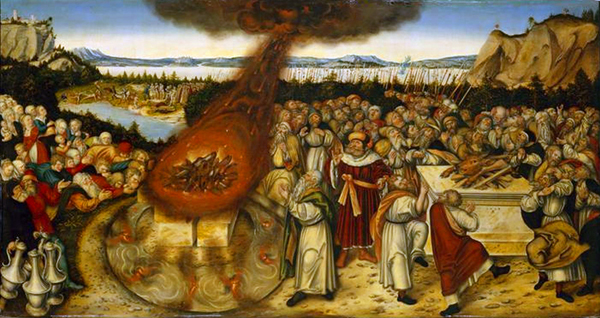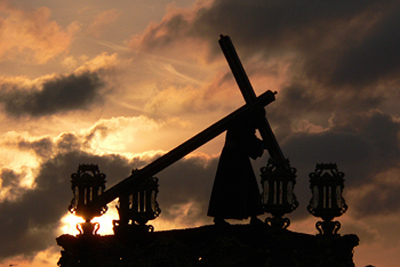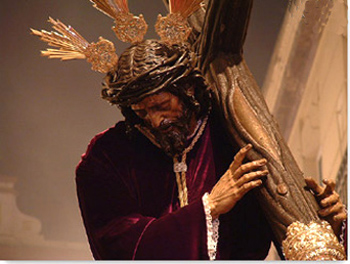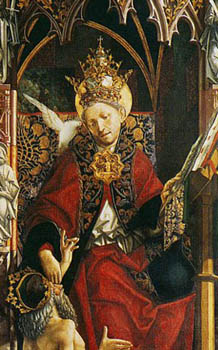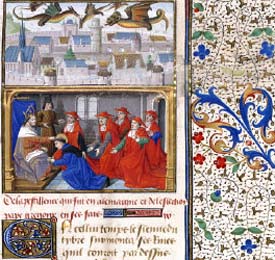The New Raccolta
Or Collection of Prayers and Good Works.
To which the Sovereign Pontiffs have attached Holy Indulgences.
Published in 1898 by order of His Holiness, Pope Leo XIII.
From the Third Italian Edition Authorized and Approved by the Sacred Congregation of Holy Indulgences. Philadelphia: Peter F. Cunningham & Son, 825 Arch Street. 1903.

THE MOST BLESSED VIRGIN MARY.
5.
CHAPLET OF THE SEVEN DOLORS.
Act of Contrition
O Savior, my sole and only love! See me before thy divine presence, all confusion by reason of the many grievous injuries I have done Thee. With my whole heart I ask thy pardon for them; repenting of them out of pure love for thee, and, at the thought of thy great goodness, hating and loathing them above every other evil of this life. Would that I had died a thousand times ere ever I had offended thee! But now I am most firmly resolved to lose my life a thousand times rather than to offend thee again. My Jesus crucified, I firmly purpose to cleanse my soul forthwith by thy most precious blood, in the sacrament of penance. And thou, most tender Virgin, mother of mercy, and refuge of the sinner, do thou by thy bitter pains, obtain for me the pardon of my sins. Meanwhile, praying, in accordance with the wishes of so many holy Pontiffs, for the indulgences attached to this chaplet, I hope thereby to obtain remission of all the punishment due to my sins.
I. With this heartfelt confidence, I meditate on the first dolor, when Mary, virgin mother of my God, presented Jesus her only-begotten Son, in the temple, laid him in the arms of holy old Simeon, and heard his word of prophecy, “A sword shall pierce thy own soul,” which foretold the passion and death of her son Jesus.
Our Father, once, Hail Mary, seven times.
II. The second dolor of the blessed Virgin was when she had to fly into Egypt on account of the persecution of cruel Herod, who impiously sought to slay her well-beloved Son.
Our Father, once, Hail Mary, seven times.
III. The third dolor of the blessed Virgin was when, after having gone up to Jerusalem, at the Passover, with Joseph, her spouse, and Jesus, her beloved Son, she missed him while returning to her humble dwelling, and for three days bewailed the loss of her sole-beloved one.
Our Father, once, Hail Mary, seven times.
IV. The Fourth dolor of the blessed Virgin was when she met her most loving Son, Jesus, carrying on his tender shoulders the heavy cross, whereon he was to be crucified for our salvation.
Our Father, once, Hail Mary, seven times.
V. The Fifth dolor of the blessed Virgin was when she saw her Son, Jesus raised upon the tree of the cross, and all his sacred body pour forth blood; and then, after three long hours of agony, beheld him die.
Our Father, once, Hail Mary, seven times.
VI. The sixth dolor of the blessed Virgin was when she saw the lance pierce the sacred side of Jesus, her beloved Son, and then received his holy body taken down from the cross and laid in her stainless bosom.
Our Father, once, Hail Mary, seven times.
VII. The seventh and last dolor of the blessed Virgin, queen and advocate of us, her servants, miserable sinners, was when she saw the holy body of her Son laid in the sepulchre.
Our Father, once, Hail Mary, seven times.
Then say the Hail Mary three times, in veneration for the tears which Mary shed in her sorrows, to obtain thereby true sorrow for our sins, and the holy indulgences attached to this pious exercise.
V. Ora pro nobis, virgo dolorosissima. R. That we may be made worthy of the promise of Christ.
Oremus.
Interveniat pro nobis, quaesumus, Domine Jesu Christe, nuncet in hora mortis nostrae, apud tuuam clementiam, beata virgo Maria mater tua. cujus sacratissimam animam in hora tuae passionis doloris gladius pertransivit. Per te, Jesu Christie, salvator mundi, qui cum Patre et Spiritu Sancto vivis et regnas, etc. Amen.
Let us Pray.
Grant, we beseech thee, O Lord Jesus Christ, that the most Blessed Virgin Mary, thy Mother, may intercede for us before the throne of thy mercy, and at the hour of our death, through whose most holy soul, in the hour of thine own passion, the sword of sorrow passed. Through thee, Jesus Christ, Savior of the world, who livest and reignest, with the Father and the Holy Ghost, for ever and ever. Amen.
The Sovereign Pontiffs, Benedict XIII., by the brief, Redemptoris Domini, Sept. 26, 1724; Clement XII., by the brief, Unigeniti Filii Dei, Dec 12, 1734, and Pius IX., by a rescript of the S. Congr. Of Indulgences, July 18, 1877, granted or confirmed the following indulgences:
AN INDULGENCE OF TWO HUNDRED DAYS, for every Our Father, and the same for every Hail Mary, to all the faithful who, being truly penitent, after confession, or at least with a firm purpose of going to confession, shall say this chaplet in a church of the Order of the Servants of Mary, or who shall practice this devotion anywhere on Fridays during Lent, and on the feast and during the octave of the Seven Dolors of the blessed Virgin Mary.
AN INDULGENCE OF ONE HUNDRED DAYS for each Our Father and each Hail Mary to those who shall perform this pious exercise anywhere, on any day of the year.
AN INDULGENCE OF SEVEN YEARS AND SEVEN QUARANTINES to anyone who shall say this chaplet, alone or in company with others.
AN INDULGENCE OF ONE HUNDRED YEARS to those who have received the chaplet directly from a religious of the Order of the Servants of Mary, every time that, being truly penitent, after confession, or at least with a firm purpose of going to confession, they shall say it with devotion.
AN INDULGENCE OF ONE HUNDRED AND FIFTY YEARS to those who shall say it on Mondays, Wednesdays, and Fridays and feasts of obligation, provided that, being truly penitent, after confession, they shall have received it directly from a religious of the same order, and carry it about them.
AN INDULGENCE OF TWO HUNDRED YEARS to all the faithful who, having made an exact examination of conscience, being truly penitent, after confession, shall say this chaplet with devotion and pray for the intention of the Sovereign Pontiff.
AN INDULGENCE OF TEN YEARS to those who keep one of these chaplets about them, and say it frequently, every time that, being truly penitent, after confession and communion, they shall assist at mass or hear a sermon with due attention, or accompany the blessed sacrament when carried to the sick, or reconcile enemies, or bring sinners to repentance, or say the Our Father and the Hail Mary seven times, or do any spiritual or corporal work of mercy, in honor of our Lord Jesus Christ, the blessed Virgin, or their patron saint.
A PLENARY INDULGENCE, once a year, to all those who have the pious custom of saying it four times a week, on any day when, being truly penitent, after confession and communion, they shall say it with devotion.
A PLENARY INDULGENCE, once a month, to all those who shall say it every day for a month, if, being truly penitent, after confession and communion, they shall pray for the intention of the Sovereign Pontiff.
As for the gaining of the indulgences, besides reciting the prescribed Our Fathers and Hail Marys, the mention and consideration of the principal sorrows which the blessed Virgin Mary suffered in the life and death of her divine Son is necessary, and as not only idiots, but many others among the faithful, have not always the capacity for meditating, his Holiness, Pope Leo XIII., by a rescript of the S. Congr. of Indulgences, May 15, 1886, has permitted that the indulgences spoken of in Nos. 1, 2, 3, 4, 7 and 9 may be gained by those of the faithful who, for whatever reason, in reciting the Crown of the Seven Dolors, do not apply themselves either to reading or meditating upon the same Dolors, provided however, that they comply with the other conditions imposed.
To obtain the above indulgences it is necessary that the rosary should be blessed by the Superiors of the Order of the Servants of Mary, or by others of the same order deputed by these Superiors, and held in the hand whilst reciting it. By a grant of His Holiness, Leo XIII. (rescript of the S.C. Of Indulgences, June 8, 1898), where two or more persons recite it together on may hold the rosary and the others, putting aside anything that would interfere with interior recollection, may thus unite in prayer with the one holding the rosary.
These rosaries may also be blessed by other priests holding special faculties, but in that case the faithful cannot gain the indulgences Nos. 4 and 5.







